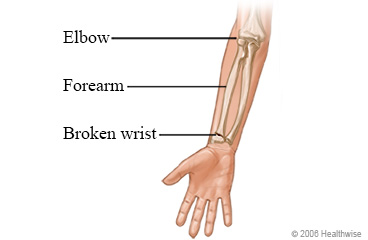
Overview
The wrist can break, or fracture, during sports, a fall, or other accidents. A break may happen when the wrist is hit or is used to protect against a fall. Fractures can range from a small, hairline crack, to a bone or bones broken into two or more pieces. Your child's treatment depends on how bad the break is.
The doctor may have put your child's wrist in a cast or splint. This will help keep the wrist stable until your child's follow-up appointment. It may take weeks or months for the wrist to heal. You can help it heal with care at home.
Healthy habits can help your child heal. Give your child a variety of healthy foods. And don't smoke around your child.
Follow-up care is a key part of your child's treatment and safety. Be sure to make and go to all appointments, and call your doctor if your child is having problems. It's also a good idea to know your child's test results and keep a list of the medicines your child takes.
How can you care for your child at home?
- Put ice or a cold pack on your child's wrist for 10 to 20 minutes at a time. Try to do this every 1 to 2 hours for the next 3 days (when your child is awake). Put a thin cloth between the ice and your child's cast or splint. Keep the cast or splint dry.
- Follow the splint or cast care instructions the doctor gives you. If your child has a splint, do not take it off unless the doctor tells you to. Be careful not to put the splint on too tight.
- Be safe with medicines. Give pain medicines exactly as directed.
- If the doctor gave your child a prescription medicine for pain, give it as prescribed.
- If your child is not taking a prescription pain medicine, ask the doctor if your child can take an over-the-counter medicine.
- Prop up the wrist on pillows when your child sits or lies down in the first few days after the injury. Keep the hand higher than the level of your child's heart. This will help reduce swelling.
- Have your child wiggle their fingers often to reduce swelling and stiffness, but tell your child to not use that hand to grab or carry anything.
- Help your child follow instructions for exercises to keep the arm strong.
When should you call for help?
Call 911 anytime you think your child may need emergency care. For example, call if:
- Your child is very sleepy and is hard to wake up.
Call your doctor now or seek immediate medical care if:
- Your child has new or worse pain.
- Your child's hand or fingers are cool or pale or change color.
- Your child's cast or splint feels too tight.
- Your child has tingling, weakness, or numbness in the hand or fingers.
Watch closely for changes in your child's health, and be sure to contact your doctor if:
- Your child does not get better as expected.
- Your child has problems with the cast or splint.
Where can you learn more?
Go to http://www.healthwise.net/patientEd
Enter Y920 in the search box to learn more about "Broken Wrist in Children: Care Instructions".
Current as of: July 17, 2023
Author: Healthwise Staff
Clinical Review Board
All Healthwise education is reviewed by a team that includes physicians, nurses, advanced practitioners, registered dieticians, and other healthcare professionals.

